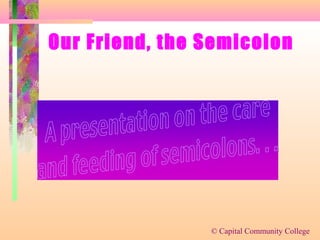More Related Content
Similar to Semicolon (13)
Semicolon
- 2. Our Friend, the Semicolon
Let’s begin with a simple sentence:
Grandma stays up too late.
© Capital Community College
- 3. Our Friend, the Semicolon
Now let’s expand on that a bit:
Grandma stays up too late. She’s afraid she’s going
to miss something.
This is OK. Two independent ideas,
separated by a period.
© Capital Community College
- 4. Our Friend, the Semicolon
What if we try to combine the two ideas?
Grandma stays up too late, she’s afraid she’s going
to miss something.
Something’s wrong. We connected two independent clauses
with only a comma. The dreaded COMMA SPLICE!
© Capital Community College
- 5. Our Friend, the Semicolon
We could insert a coordinating conjunction:
Grandma is afraid she’ll miss something, so she
stays up too late.
This is better! Note the comma that accompanies
the coordinating conjunction.
© Capital Community College
- 6. Our Friend, the Semicolon
We could also try subordinating one of these ideas:
Grandma stays up too late because she’s afraid
she’s going to miss something.
Notice that the comma disappeared. One idea (the
second one) now depends on the other; it has
become a dependent clause.
© Capital Community College
- 7. Our Friend, the Semicolon
But let’s try something else.
© Capital Community College
- 8. Our Friend, the Semicolon
Let’s try using a semicolon in this sentence.
;
Grandma stays up too late she’s afraid she’s going
to miss something.
Notice there is no conjunction used with this
semicolon – either subordinating or coordinating.
Just the semicolon, all by itself.
© Capital Community College
- 9. Our Friend, the Semicolon
Sometimes semicolons are accompanied by
conjunctive adverbs – words such as however,
moreover, therefore, nevertheless, consequently,
as a result.
Grandma is afraid she’s going to miss something;
as a result, she stays up too late.
© Capital Community College
- 10. Our Friend, the Semicolon
Notice the pattern:
; as a result,
semicolon + conjunctive adverb + comma
This is a typical construction with semicolons.
© Capital Community College
- 11. Our Friend, the Semicolon
There is one other use of the semicolon: to help us
sort out monster lists, like this one:
lists
The committee included Peter Wursthorn, Professor of
Mathematics, from Marlborough, Connecticut, Virginia
Villa, Professor of English, from Hartford, Connecticut, Paul
Creech, Director of Rad-Tech, from Essex, Connecticut, and
Joan Leach, Professor of Nursing, from Farmington,
Connecticut.
© Capital Community College
- 12. Our Friend, the Semicolon
Be careful where you insert semicolons in this
sentence.
The committee included Peter Wursthorn, Professor of
Mathematics, from Marlborough, Connecticut; Virginia
Villa, Professor of English, from Hartford, Connecticut ; Paul
Creech, Director of Rad-Tech, from Essex, Connecticut ; and
Joan Leach, Professor of Nursing, from Farmington,
Connecticut.
© Capital Community College
- 13. Our Friend, the Semicolon
Now you know everything you’ll ever need to know
about using semicolons!
© Capital Community College
- 14. This PowerPoint presentation was created by
Charles Darling, PhD
Professor of English and Webmaster
Capital Community College
Hartford, Connecticut
copyright November 1999
© Capital Community College
Editor's Notes
- 1
- 2
- 3
- 4
- 5
- 6
- 7
- 8
- 9
- 10
- 11
- 12
- 13
